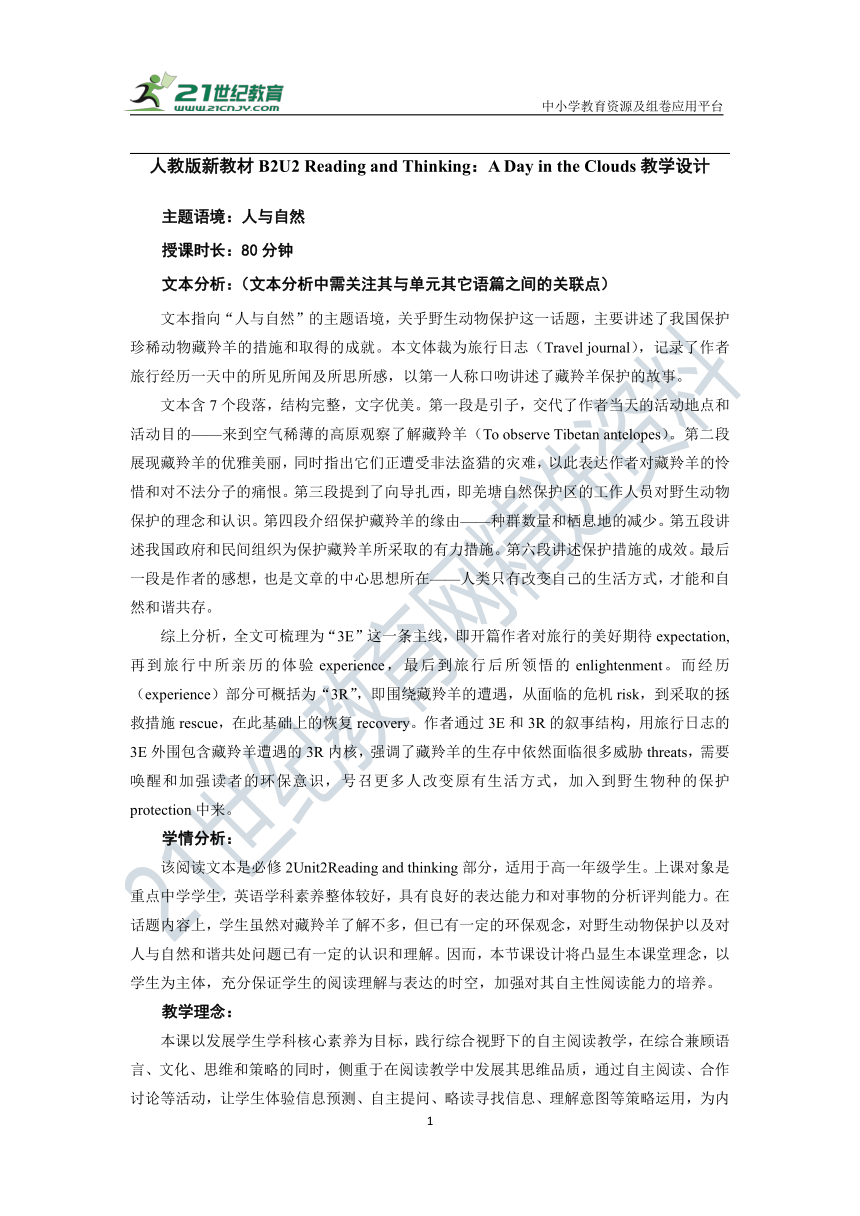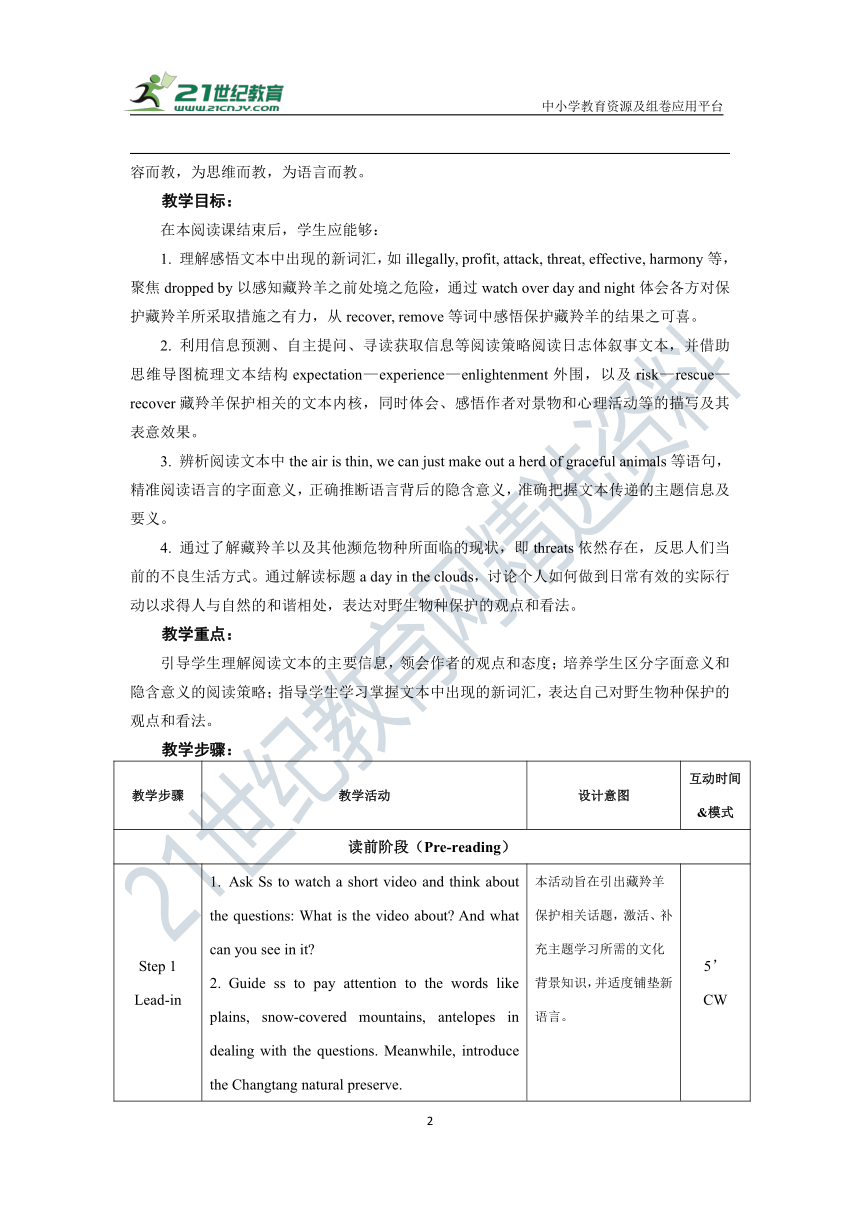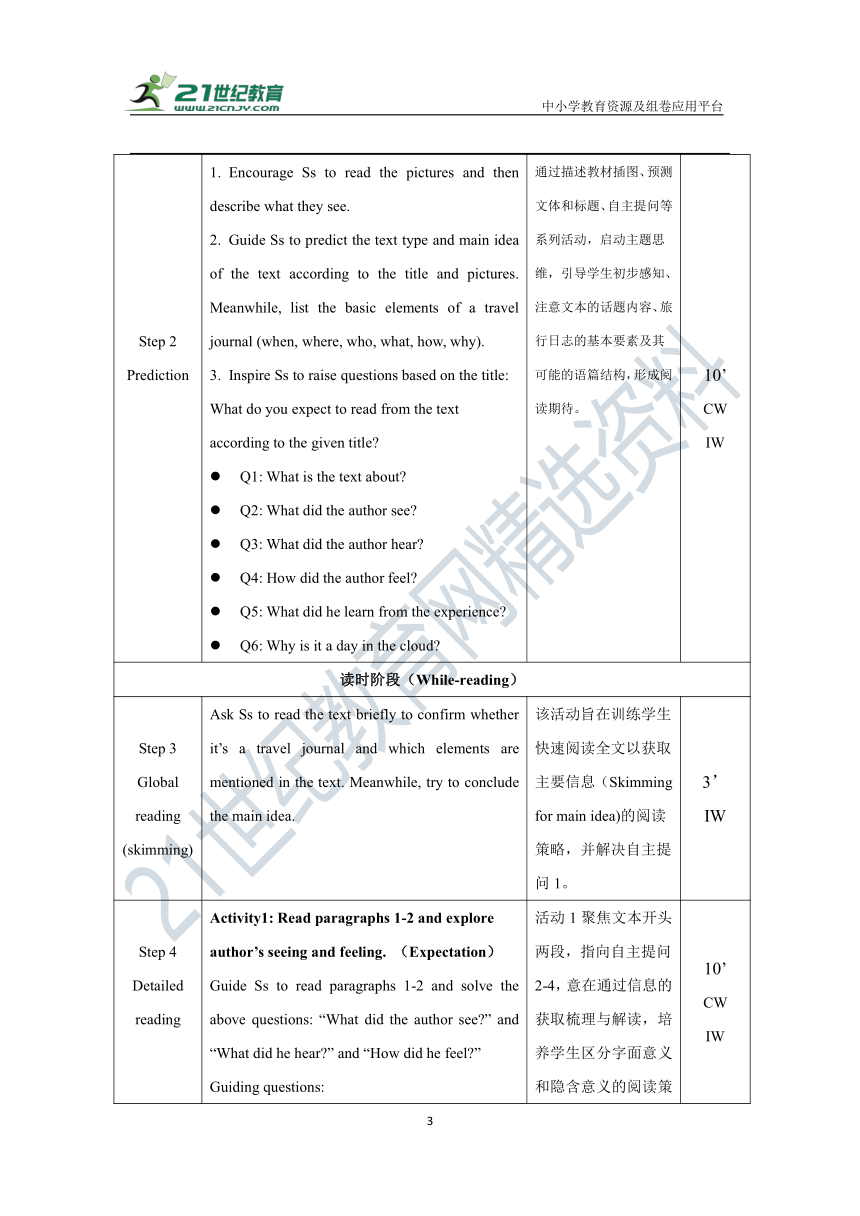人教版(2019)必修第二册 Unit 2 Wildlife protection Reading and Thinking 教学设计
文档属性
| 名称 | 人教版(2019)必修第二册 Unit 2 Wildlife protection Reading and Thinking 教学设计 |  | |
| 格式 | docx | ||
| 文件大小 | 146.9KB | ||
| 资源类型 | 试卷 | ||
| 版本资源 | 人教版(2019) | ||
| 科目 | 英语 | ||
| 更新时间 | 2024-09-20 20:06:11 | ||
图片预览



文档简介
中小学教育资源及组卷应用平台
人教版新教材B2U2 Reading and Thinking:A Day in the Clouds教学设计
主题语境:人与自然
授课时长:80分钟
文本分析:(文本分析中需关注其与单元其它语篇之间的关联点)
文本指向“人与自然”的主题语境,关乎野生动物保护这一话题,主要讲述了我国保护珍稀动物藏羚羊的措施和取得的成就。本文体裁为旅行日志(Travel journal),记录了作者旅行经历一天中的所见所闻及所思所感,以第一人称口吻讲述了藏羚羊保护的故事。
文本含7个段落,结构完整,文字优美。第一段是引子,交代了作者当天的活动地点和活动目的——来到空气稀薄的高原观察了解藏羚羊(To observe Tibetan antelopes)。第二段展现藏羚羊的优雅美丽,同时指出它们正遭受非法盗猎的灾难,以此表达作者对藏羚羊的怜惜和对不法分子的痛恨。第三段提到了向导扎西,即羌塘自然保护区的工作人员对野生动物保护的理念和认识。第四段介绍保护藏羚羊的缘由——种群数量和栖息地的减少。第五段讲述我国政府和民间组织为保护藏羚羊所采取的有力措施。第六段讲述保护措施的成效。最后一段是作者的感想,也是文章的中心思想所在——人类只有改变自己的生活方式,才能和自然和谐共存。
综上分析,全文可梳理为“3E”这一条主线,即开篇作者对旅行的美好期待expectation, 再到旅行中所亲历的体验experience,最后到旅行后所领悟的enlightenment。而经历(experience)部分可概括为“3R”,即围绕藏羚羊的遭遇,从面临的危机risk,到采取的拯救措施rescue,在此基础上的恢复recovery。作者通过3E和3R的叙事结构,用旅行日志的3E外围包含藏羚羊遭遇的3R内核,强调了藏羚羊的生存中依然面临很多威胁threats,需要唤醒和加强读者的环保意识,号召更多人改变原有生活方式,加入到野生物种的保护protection中来。
学情分析:
该阅读文本是必修2Unit2Reading and thinking部分,适用于高一年级学生。上课对象是重点中学学生,英语学科素养整体较好,具有良好的表达能力和对事物的分析评判能力。在话题内容上,学生虽然对藏羚羊了解不多,但已有一定的环保观念,对野生动物保护以及对人与自然和谐共处问题已有一定的认识和理解。因而,本节课设计将凸显生本课堂理念,以学生为主体,充分保证学生的阅读理解与表达的时空,加强对其自主性阅读能力的培养。
教学理念:
本课以发展学生学科核心素养为目标,践行综合视野下的自主阅读教学,在综合兼顾语言、文化、思维和策略的同时,侧重于在阅读教学中发展其思维品质,通过自主阅读、合作讨论等活动,让学生体验信息预测、自主提问、略读寻找信息、理解意图等策略运用,为内容而教,为思维而教,为语言而教。
教学目标:
在本阅读课结束后,学生应能够:
1. 理解感悟文本中出现的新词汇,如illegally, profit, attack, threat, effective, harmony等,聚焦dropped by以感知藏羚羊之前处境之危险,通过watch over day and night体会各方对保护藏羚羊所采取措施之有力,从recover, remove等词中感悟保护藏羚羊的结果之可喜。
2. 利用信息预测、自主提问、寻读获取信息等阅读策略阅读日志体叙事文本,并借助思维导图梳理文本结构expectation—experience—enlightenment外围,以及risk—rescue—recover藏羚羊保护相关的文本内核,同时体会、感悟作者对景物和心理活动等的描写及其表意效果。
3. 辨析阅读文本中the air is thin, we can just make out a herd of graceful animals等语句,精准阅读语言的字面意义,正确推断语言背后的隐含意义,准确把握文本传递的主题信息及要义。
4. 通过了解藏羚羊以及其他濒危物种所面临的现状,即threats依然存在,反思人们当前的不良生活方式。通过解读标题a day in the clouds,讨论个人如何做到日常有效的实际行动以求得人与自然的和谐相处,表达对野生物种保护的观点和看法。
教学重点:
引导学生理解阅读文本的主要信息,领会作者的观点和态度;培养学生区分字面意义和隐含意义的阅读策略;指导学生学习掌握文本中出现的新词汇,表达自己对野生物种保护的观点和看法。
教学步骤:
教学步骤 教学活动 设计意图 互动时间&模式
读前阶段(Pre-reading)
Step 1 Lead-in Ask Ss to watch a short video and think about the questions: What is the video about And what can you see in it Guide ss to pay attention to the words like plains, snow-covered mountains, antelopes in dealing with the questions. Meanwhile, introduce the Changtang natural preserve. 本活动旨在引出藏羚羊保护相关话题,激活、补充主题学习所需的文化背景知识,并适度铺垫新语言。 5’ CW
Step 2 Prediction Encourage Ss to read the pictures and then describe what they see. Guide Ss to predict the text type and main idea of the text according to the title and pictures. Meanwhile, list the basic elements of a travel journal (when, where, who, what, how, why). Inspire Ss to raise questions based on the title: What do you expect to read from the text according to the given title Q1: What is the text about Q2: What did the author see Q3: What did the author hear Q4: How did the author feel Q5: What did he learn from the experience Q6: Why is it a day in the cloud 通过描述教材插图、预测文体和标题、自主提问等系列活动,启动主题思维,引导学生初步感知、注意文本的话题内容、旅行日志的基本要素及其可能的语篇结构,形成阅读期待。 10’ CW IW
读时阶段(While-reading)
Step 3 Global reading (skimming) Ask Ss to read the text briefly to confirm whether it’s a travel journal and which elements are mentioned in the text. Meanwhile, try to conclude the main idea. 该活动旨在训练学生快速阅读全文以获取主要信息(Skimming for main idea)的阅读策略,并解决自主提问1。 3’ IW
Step 4 Detailed reading Activity1: Read paragraphs 1-2 and explore author’s seeing and feeling. (Expectation) Guide Ss to read paragraphs 1-2 and solve the above questions: “What did the author see ” and “What did he hear ” and “How did he feel ” Guiding questions: ①What did the author see ②Why does the writer call it a day in the clouds [Possible answers: The air is thin./snow-covered mountains/Tibetan antelope.] ③What does the sentence “The air is thin” mean Try to identify the literal and implied meaning of the sentence. ④Could you use one word to describe the scene of expectation ⑤What did he hear ⑥How did he feel according to paragraph 2 活动1聚焦文本开头两段,指向自主提问2-4,意在通过信息的获取梳理与解读,培养学生区分字面意义和隐含意义的阅读策略,体悟隐含意义对理解文本的深层含义的主要作用和意义。 10’ CW IW
Activity 2: Read paragraphs 3-6 and draw a mind map. (Experience) Remind Ss of the danger antelopes faced and guide them to predict: What may be mentioned in the next few paragraphs [Problem—Solution—Result] Give Ss a brief introduction to Zhaxi and Changtang preserve. Encourage Ss to read paragraphs 3-6 uninterruptedly and then draw a mind map in groups based on the structure of “problems—solutions—results”. Ask several Ss to share and illustrate the mind map they’ve drawn. Guide Ss to further explore the paragraphs 3-6 from the perspectives of “problems—solutions—results”. [Problems—Risks: illegal hunting, shooting for profits, habitat loss] [Solutions—Rescue: national protection, facilities, voluntary work] [Results—Recovery: increase in population, removed from the endangered species list] Extended thinking in dealing with Q5: ①How do you understand the quote from the Wild Aid “When the buying stops, the killing too.” ②What does “national protection” mean And what does “drop by”“mean ③Does the government intend to stop the protection programs What do you think are the threats to the Tibetan antelopes ④What contributes to successful recovery of antelopes in number [human’s constant efforts, national joint efforts] 活动2围绕第3-6段,解决自主提问2-4。依托自主阅读并构建思维导图、分享阐述思维导图、深入探究思维导图三个层次来引导深度分析文本,形成对“问题(Risk)—解决(Rescue)—结果(Recovery)这一篇章结构的整体把握。在此过程中,依托拓展性问题的思考,更深层次分析推断危机背后之根本原因、促成动物数量回升背后的相关因素、动物保护的潜在威胁等深层次问题,进而感悟改变当前人们不良生活方式,并为之不断努力、共同努力的重要意义。 27’ IW GW CW
Activity 3: Read paragraph 7 and think critically about his reflection and enlightenment.(Enlightenment) Guide Ss to read the last paragraph and think about the following questions: ①How did the author feel about his day ②What is the writing tone of the paragraph ③How does the writer feel about modern life What did he learn from the visit Inspire Ss to discuss the question in groups of four: What can we do to change our life and exist in harmony with nature Human’s constant efforts Appeal for awareness Respect for nature Maintenance of beauty Objections to hurting National joint efforts Youth’s participation 活动3指向对段落7的解读,解决学生的两个自主提问“How did the author feel ”和“What did he learn from the experience ”在此基础上,引导学生联结生活、联系自我,通过小组讨论,在回应原文关键信息的过程中,个性化思考、阐释在改变人们生活方式、促成人与自然的和谐共处中我们的可做可为。 15’ IW GW CW
读后阶段(Post-reading)
Step 5 Reading for theme: Interpreting the title Guide Ss to reread the title “a day in the clouds” and think about: Why does the author use this title What is the purpose of writing this travel journal Encourage Ss to make a summary of what they’ve learned from the text with one sentence in pairs. Share the summary with Ss: Whoever we are, wherever we go, whatever we do, we should care for wildlife and protect our beautiful home. 依托深化理解类读后活动,通过再次解读标题,深度分析推断作者的写作意图。基于此,引导学生以一句话总结所学内容的方式,个性化表达主题意义和观点思想。 10’ IW PW CW
Step 6 Homework Ask Ss to write a speech about the wildlife protection. The situation: Suppose you were the writer, you are going to make a speech about your travel to the students in your school. (100 words) The content: —What you saw, heard and felt during the travel; —Advice to the students on how to live in harmony with nature. 基于所创设情境,依托建构创造类读后活动,迁移、运用主题内容及语言,建构新语篇。
备注:Ss: Students IW: Individual work GW: Group work CW: Class work
板书设计:
A Day in the Clouds
(
expectation
risk
A
day
in the clouds experience rescue
recover
enlightenment
)What did the author see
What did the author hear
How did the author feel
What did he learn from the experience
Why is it a day in the cloud
(
I
llegal hunting, sacred, drop by, make profits, watch over, effective
…
)
(
H
uman’s constant efforts
A
ppeal for awareness
R
espect for nature
M
aintenance of beauty
O
bjections to hurting
N
ational joint efforts
Y
outh’s participation
)
7
人教版新教材B2U2 Reading and Thinking:A Day in the Clouds教学设计
主题语境:人与自然
授课时长:80分钟
文本分析:(文本分析中需关注其与单元其它语篇之间的关联点)
文本指向“人与自然”的主题语境,关乎野生动物保护这一话题,主要讲述了我国保护珍稀动物藏羚羊的措施和取得的成就。本文体裁为旅行日志(Travel journal),记录了作者旅行经历一天中的所见所闻及所思所感,以第一人称口吻讲述了藏羚羊保护的故事。
文本含7个段落,结构完整,文字优美。第一段是引子,交代了作者当天的活动地点和活动目的——来到空气稀薄的高原观察了解藏羚羊(To observe Tibetan antelopes)。第二段展现藏羚羊的优雅美丽,同时指出它们正遭受非法盗猎的灾难,以此表达作者对藏羚羊的怜惜和对不法分子的痛恨。第三段提到了向导扎西,即羌塘自然保护区的工作人员对野生动物保护的理念和认识。第四段介绍保护藏羚羊的缘由——种群数量和栖息地的减少。第五段讲述我国政府和民间组织为保护藏羚羊所采取的有力措施。第六段讲述保护措施的成效。最后一段是作者的感想,也是文章的中心思想所在——人类只有改变自己的生活方式,才能和自然和谐共存。
综上分析,全文可梳理为“3E”这一条主线,即开篇作者对旅行的美好期待expectation, 再到旅行中所亲历的体验experience,最后到旅行后所领悟的enlightenment。而经历(experience)部分可概括为“3R”,即围绕藏羚羊的遭遇,从面临的危机risk,到采取的拯救措施rescue,在此基础上的恢复recovery。作者通过3E和3R的叙事结构,用旅行日志的3E外围包含藏羚羊遭遇的3R内核,强调了藏羚羊的生存中依然面临很多威胁threats,需要唤醒和加强读者的环保意识,号召更多人改变原有生活方式,加入到野生物种的保护protection中来。
学情分析:
该阅读文本是必修2Unit2Reading and thinking部分,适用于高一年级学生。上课对象是重点中学学生,英语学科素养整体较好,具有良好的表达能力和对事物的分析评判能力。在话题内容上,学生虽然对藏羚羊了解不多,但已有一定的环保观念,对野生动物保护以及对人与自然和谐共处问题已有一定的认识和理解。因而,本节课设计将凸显生本课堂理念,以学生为主体,充分保证学生的阅读理解与表达的时空,加强对其自主性阅读能力的培养。
教学理念:
本课以发展学生学科核心素养为目标,践行综合视野下的自主阅读教学,在综合兼顾语言、文化、思维和策略的同时,侧重于在阅读教学中发展其思维品质,通过自主阅读、合作讨论等活动,让学生体验信息预测、自主提问、略读寻找信息、理解意图等策略运用,为内容而教,为思维而教,为语言而教。
教学目标:
在本阅读课结束后,学生应能够:
1. 理解感悟文本中出现的新词汇,如illegally, profit, attack, threat, effective, harmony等,聚焦dropped by以感知藏羚羊之前处境之危险,通过watch over day and night体会各方对保护藏羚羊所采取措施之有力,从recover, remove等词中感悟保护藏羚羊的结果之可喜。
2. 利用信息预测、自主提问、寻读获取信息等阅读策略阅读日志体叙事文本,并借助思维导图梳理文本结构expectation—experience—enlightenment外围,以及risk—rescue—recover藏羚羊保护相关的文本内核,同时体会、感悟作者对景物和心理活动等的描写及其表意效果。
3. 辨析阅读文本中the air is thin, we can just make out a herd of graceful animals等语句,精准阅读语言的字面意义,正确推断语言背后的隐含意义,准确把握文本传递的主题信息及要义。
4. 通过了解藏羚羊以及其他濒危物种所面临的现状,即threats依然存在,反思人们当前的不良生活方式。通过解读标题a day in the clouds,讨论个人如何做到日常有效的实际行动以求得人与自然的和谐相处,表达对野生物种保护的观点和看法。
教学重点:
引导学生理解阅读文本的主要信息,领会作者的观点和态度;培养学生区分字面意义和隐含意义的阅读策略;指导学生学习掌握文本中出现的新词汇,表达自己对野生物种保护的观点和看法。
教学步骤:
教学步骤 教学活动 设计意图 互动时间&模式
读前阶段(Pre-reading)
Step 1 Lead-in Ask Ss to watch a short video and think about the questions: What is the video about And what can you see in it Guide ss to pay attention to the words like plains, snow-covered mountains, antelopes in dealing with the questions. Meanwhile, introduce the Changtang natural preserve. 本活动旨在引出藏羚羊保护相关话题,激活、补充主题学习所需的文化背景知识,并适度铺垫新语言。 5’ CW
Step 2 Prediction Encourage Ss to read the pictures and then describe what they see. Guide Ss to predict the text type and main idea of the text according to the title and pictures. Meanwhile, list the basic elements of a travel journal (when, where, who, what, how, why). Inspire Ss to raise questions based on the title: What do you expect to read from the text according to the given title Q1: What is the text about Q2: What did the author see Q3: What did the author hear Q4: How did the author feel Q5: What did he learn from the experience Q6: Why is it a day in the cloud 通过描述教材插图、预测文体和标题、自主提问等系列活动,启动主题思维,引导学生初步感知、注意文本的话题内容、旅行日志的基本要素及其可能的语篇结构,形成阅读期待。 10’ CW IW
读时阶段(While-reading)
Step 3 Global reading (skimming) Ask Ss to read the text briefly to confirm whether it’s a travel journal and which elements are mentioned in the text. Meanwhile, try to conclude the main idea. 该活动旨在训练学生快速阅读全文以获取主要信息(Skimming for main idea)的阅读策略,并解决自主提问1。 3’ IW
Step 4 Detailed reading Activity1: Read paragraphs 1-2 and explore author’s seeing and feeling. (Expectation) Guide Ss to read paragraphs 1-2 and solve the above questions: “What did the author see ” and “What did he hear ” and “How did he feel ” Guiding questions: ①What did the author see ②Why does the writer call it a day in the clouds [Possible answers: The air is thin./snow-covered mountains/Tibetan antelope.] ③What does the sentence “The air is thin” mean Try to identify the literal and implied meaning of the sentence. ④Could you use one word to describe the scene of expectation ⑤What did he hear ⑥How did he feel according to paragraph 2 活动1聚焦文本开头两段,指向自主提问2-4,意在通过信息的获取梳理与解读,培养学生区分字面意义和隐含意义的阅读策略,体悟隐含意义对理解文本的深层含义的主要作用和意义。 10’ CW IW
Activity 2: Read paragraphs 3-6 and draw a mind map. (Experience) Remind Ss of the danger antelopes faced and guide them to predict: What may be mentioned in the next few paragraphs [Problem—Solution—Result] Give Ss a brief introduction to Zhaxi and Changtang preserve. Encourage Ss to read paragraphs 3-6 uninterruptedly and then draw a mind map in groups based on the structure of “problems—solutions—results”. Ask several Ss to share and illustrate the mind map they’ve drawn. Guide Ss to further explore the paragraphs 3-6 from the perspectives of “problems—solutions—results”. [Problems—Risks: illegal hunting, shooting for profits, habitat loss] [Solutions—Rescue: national protection, facilities, voluntary work] [Results—Recovery: increase in population, removed from the endangered species list] Extended thinking in dealing with Q5: ①How do you understand the quote from the Wild Aid “When the buying stops, the killing too.” ②What does “national protection” mean And what does “drop by”“mean ③Does the government intend to stop the protection programs What do you think are the threats to the Tibetan antelopes ④What contributes to successful recovery of antelopes in number [human’s constant efforts, national joint efforts] 活动2围绕第3-6段,解决自主提问2-4。依托自主阅读并构建思维导图、分享阐述思维导图、深入探究思维导图三个层次来引导深度分析文本,形成对“问题(Risk)—解决(Rescue)—结果(Recovery)这一篇章结构的整体把握。在此过程中,依托拓展性问题的思考,更深层次分析推断危机背后之根本原因、促成动物数量回升背后的相关因素、动物保护的潜在威胁等深层次问题,进而感悟改变当前人们不良生活方式,并为之不断努力、共同努力的重要意义。 27’ IW GW CW
Activity 3: Read paragraph 7 and think critically about his reflection and enlightenment.(Enlightenment) Guide Ss to read the last paragraph and think about the following questions: ①How did the author feel about his day ②What is the writing tone of the paragraph ③How does the writer feel about modern life What did he learn from the visit Inspire Ss to discuss the question in groups of four: What can we do to change our life and exist in harmony with nature Human’s constant efforts Appeal for awareness Respect for nature Maintenance of beauty Objections to hurting National joint efforts Youth’s participation 活动3指向对段落7的解读,解决学生的两个自主提问“How did the author feel ”和“What did he learn from the experience ”在此基础上,引导学生联结生活、联系自我,通过小组讨论,在回应原文关键信息的过程中,个性化思考、阐释在改变人们生活方式、促成人与自然的和谐共处中我们的可做可为。 15’ IW GW CW
读后阶段(Post-reading)
Step 5 Reading for theme: Interpreting the title Guide Ss to reread the title “a day in the clouds” and think about: Why does the author use this title What is the purpose of writing this travel journal Encourage Ss to make a summary of what they’ve learned from the text with one sentence in pairs. Share the summary with Ss: Whoever we are, wherever we go, whatever we do, we should care for wildlife and protect our beautiful home. 依托深化理解类读后活动,通过再次解读标题,深度分析推断作者的写作意图。基于此,引导学生以一句话总结所学内容的方式,个性化表达主题意义和观点思想。 10’ IW PW CW
Step 6 Homework Ask Ss to write a speech about the wildlife protection. The situation: Suppose you were the writer, you are going to make a speech about your travel to the students in your school. (100 words) The content: —What you saw, heard and felt during the travel; —Advice to the students on how to live in harmony with nature. 基于所创设情境,依托建构创造类读后活动,迁移、运用主题内容及语言,建构新语篇。
备注:Ss: Students IW: Individual work GW: Group work CW: Class work
板书设计:
A Day in the Clouds
(
expectation
risk
A
day
in the clouds experience rescue
recover
enlightenment
)What did the author see
What did the author hear
How did the author feel
What did he learn from the experience
Why is it a day in the cloud
(
I
llegal hunting, sacred, drop by, make profits, watch over, effective
…
)
(
H
uman’s constant efforts
A
ppeal for awareness
R
espect for nature
M
aintenance of beauty
O
bjections to hurting
N
ational joint efforts
Y
outh’s participation
)
7
